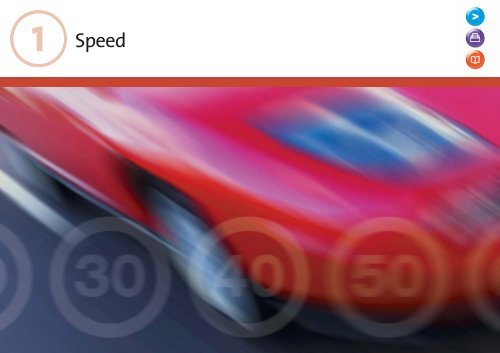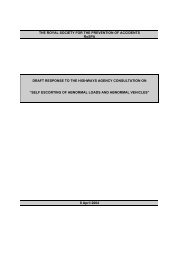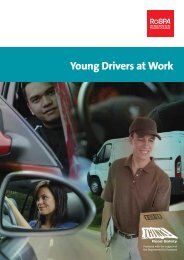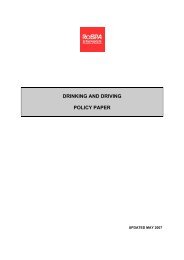Road Safety Citizenship 2 : Speed - RoSPA
Road Safety Citizenship 2 : Speed - RoSPA
Road Safety Citizenship 2 : Speed - RoSPA
Create successful ePaper yourself
Turn your PDF publications into a flip-book with our unique Google optimized e-Paper software.
1 <strong>Speed</strong>
Did you know?<br />
● Excessive speed contributes to 12% of all injury collisions, 18% of<br />
crashes resulting in a serious injury and 28% of all fatal collisions<br />
● This means that around 1,000 people are killed each year on Britain’s<br />
roads, and over 6,000 are seriously injured, because drivers and<br />
riders travel too fast.<br />
Highway Code Rule 103<br />
You MUST NOT exceed the maximum speed limits for the<br />
road and for your vehicle. Street lights usually mean that<br />
there is a 30 mph speed limit unless there are signs<br />
showing another limit.<br />
<strong>Speed</strong>ing is not just exceeding the speed limit. It is also driving<br />
within the speed limit but too fast for the conditions (known as<br />
‘inappropriate speed’). Describe some situations where it is not<br />
safe to drive as fast as the speed limit.<br />
41<br />
Discussion Points<br />
g What do you think?<br />
Find out the normal speed limits for different types of roads and<br />
different vehicles. Why do some vehicles (for example, heavy goods<br />
vehicles) have lower limits?<br />
Why are speed limits necessary? What would happen if drivers were<br />
allowed to drive at any speed they wanted? Would they all choose<br />
the same speed on a particular road? Would they choose speeds that<br />
were safe for pedestrians and cyclists?<br />
How do higher speeds make crashes more likely? How do higher<br />
speeds make collisions more serious?<br />
Stopping Distances<br />
The faster a car is travelling, the longer it takes to stop. At just<br />
30 mph, a car travels 44 feet (about 3 car lengths) each second.<br />
Using the Highway Code, make a chart showing the differences<br />
in stopping distances between various speeds in between 20<br />
mph and 70 mph. If a driver reacts slowly, the stopping<br />
distance will increase. What else increases stopping distances?<br />
As well as being dangerous itself, going too fast also makes<br />
other types of driving more dangerous, e.g. driving too close to<br />
the vehicle in front. Make a list of types of bad driving that are<br />
made even worse at higher speeds.
✐<br />
Activities<br />
For a period (a week or a month) collect articles from local and<br />
national newspapers about road crashes. Work out how many<br />
there were, how many involved car drivers, pedestrians, cyclists,<br />
etc. How many involved speeding (either exceeding the limit or<br />
driving too fast for the conditions).<br />
Produce a report showing your findings. Present this to other<br />
members of the group/class and hold a Question & Answer<br />
session with them.<br />
Did you know?<br />
● 45% of fatal and serious crashes and 53% of road deaths<br />
occur on rural roads.<br />
Why are rural roads so dangerous? Think about speed, the<br />
nature of the roads and the types of vehicles using them.<br />
✐<br />
Activities<br />
Activities<br />
<strong>Road</strong> engineering is a successful<br />
way of helping drivers drive at<br />
safe speeds.<br />
In<br />
In<br />
small<br />
small<br />
groups,<br />
groups,<br />
pick<br />
pick<br />
an<br />
an<br />
area<br />
area<br />
(a<br />
(a<br />
few<br />
few<br />
streets<br />
streets<br />
wide)<br />
wide)<br />
and<br />
design<br />
and design<br />
a road<br />
a road<br />
engineering<br />
engineering<br />
scheme<br />
scheme<br />
to reduce<br />
to reduce<br />
traffic<br />
speeds<br />
traffic speeds<br />
and make<br />
and<br />
the<br />
make<br />
roads<br />
the<br />
safer<br />
roads<br />
for<br />
safer<br />
everyone.<br />
for<br />
Some<br />
groups<br />
everyone.<br />
should<br />
Some<br />
pick<br />
groups<br />
an urban<br />
should<br />
area<br />
pick<br />
and<br />
an<br />
some<br />
urban<br />
a<br />
area<br />
rural<br />
area.<br />
and some<br />
Mark<br />
a<br />
the<br />
rural<br />
changes<br />
area. Mark<br />
you propose<br />
the changes<br />
on a<br />
you<br />
large scale<br />
map<br />
propose<br />
of the<br />
on<br />
area<br />
a large<br />
chosen<br />
scale<br />
and<br />
map<br />
produce<br />
of the area<br />
notes<br />
chosen<br />
to explain<br />
the<br />
and<br />
changes<br />
produce<br />
and<br />
notes<br />
the<br />
to<br />
reasons<br />
explain<br />
for<br />
the<br />
them.<br />
changes and the<br />
reasons for them.<br />
In an urban area, you could choose to design a 20<br />
mph<br />
In an<br />
zone<br />
urban<br />
or<br />
area,<br />
a traffic<br />
you<br />
calming<br />
could choose<br />
scheme<br />
to design<br />
(but keeping<br />
a 20<br />
the<br />
mph<br />
speed<br />
zone<br />
limit<br />
or a traffic<br />
as 30 mph).<br />
calming<br />
In a<br />
scheme<br />
rural area,<br />
(but<br />
choose a<br />
village<br />
keeping<br />
where<br />
the speed<br />
you want<br />
limit<br />
to<br />
as<br />
reduce<br />
30 mph).<br />
speeds<br />
In a rural<br />
from 60<br />
mph<br />
area,<br />
on<br />
choose<br />
the road<br />
a village<br />
approaching<br />
where you<br />
the<br />
want<br />
village<br />
to reduce<br />
to 30 mph<br />
through<br />
speeds from<br />
the village.<br />
60 mph<br />
Don’t<br />
on the<br />
forget<br />
road<br />
to<br />
approaching<br />
consider<br />
the<br />
pedestrians<br />
village to 30<br />
and<br />
mph<br />
cyclists<br />
through<br />
and<br />
the<br />
to<br />
village.<br />
include<br />
Don’t<br />
road<br />
forget<br />
markings<br />
to consider<br />
and<br />
pedestrians<br />
signs.<br />
and cyclists and to include<br />
road markings and signs.<br />
At the end of the project, each group can present<br />
their<br />
At the<br />
design<br />
end of<br />
scheme<br />
the project,<br />
to the<br />
each<br />
rest<br />
group<br />
of the<br />
can<br />
class.<br />
present<br />
their design scheme to the rest of the class.<br />
Ideas about different engineering schemes can be<br />
found<br />
Ideas about<br />
in the<br />
different<br />
DfT’s Traffic<br />
engineering<br />
Advisory Leaflets<br />
schemes<br />
and<br />
can<br />
its<br />
be<br />
"<strong>Road</strong><br />
found<br />
<strong>Safety</strong><br />
in the DfT’s<br />
Good<br />
Traffic<br />
Practice<br />
Advisory<br />
Guide".<br />
Leaflets and its<br />
"<strong>Road</strong> <strong>Safety</strong> Good Practice Guide".
<strong>Speed</strong> cameras<br />
Cameras are used to discourage drivers<br />
from exceeding the speed limit.<br />
Using the websites www.dft.gov.uk<br />
(click on <strong>Road</strong> <strong>Safety</strong> and then <strong>Safety</strong><br />
Cameras) and www.nationalsafety<br />
cameras.co.uk, find out the rules for<br />
placing speed cameras. On a road map,<br />
mark the locations of cameras in your<br />
area. Why do you think they are where<br />
they are?<br />
Write an article describing how cameras<br />
work, why they are needed and how<br />
effective they are. This could be for a<br />
local newspaper. Could you use quotes<br />
or statements from family members or<br />
friends about their views.<br />
Cars<br />
What features of car design help drivers<br />
to control their speed? Do any aspects of<br />
car design encourage drivers to go too<br />
fast? Also think about how cars are<br />
advertised and promoted. What sort of<br />
adverts would influence your choice of<br />
car and why? What else could<br />
manufacturers do to help drivers?<br />
Most speedometers are a dial with<br />
numbers around the edge and an arrow<br />
pointing towards the speed the vehicle<br />
is doing. Is this the best design? Are<br />
there other types?<br />
Design a new speedometer. Think about<br />
how it tells the driver what speed they<br />
are doing and how it could warn him or<br />
her if they are going too fast.
Did you know? A pedestrian hit by a car at:<br />
● 20 mph, has a 97% chance of<br />
surviving (almost all live)<br />
● 30 mph, has a 80% chance of<br />
surviving (most live)<br />
● 35 mph, has a 50% chance of<br />
surviving (half live, half die)<br />
● 40 mph, has only a 10% chance<br />
of surviving (almost all die).<br />
Small increases<br />
in speed have<br />
massive effects
✐<br />
Activities<br />
There are many reasons and<br />
excuses for speeding (such as<br />
“I was late”,“everyone else does<br />
it” and “I enjoy driving fast”).<br />
In a pair:<br />
● Make a list of all the reasons you<br />
can think of<br />
● Create a questionnaire (example<br />
opposite)<br />
● Ask people you know who drive<br />
(parents, their friends, teachers, etc)<br />
to complete the questionnaire<br />
● Keep the questionnaires<br />
anonymous, but record whether the<br />
respondents are male or female and<br />
their age<br />
● Collate all the responses together.<br />
<strong>Speed</strong>ing Questionnaire<br />
Produce a report analysing the results and identifying the most<br />
common reasons for speeding and any differences between men<br />
and women and between age groups.<br />
Respondent 1 Male Female Age<br />
Reason for Never Sometimes Often Always<br />
<strong>Speed</strong>ing<br />
Late<br />
Other drivers<br />
speeding<br />
I think it’s safe<br />
to speed<br />
✐<br />
Discussion Points<br />
● Brainstorm the best<br />
ways of raising<br />
awareness about the<br />
dangers of speeding.<br />
In small groups:<br />
● What methods would<br />
you use e.g. TV adverts,<br />
posters, something else?<br />
● Where would you<br />
target publicity?<br />
(locations/events)<br />
4141
✐ Activities<br />
Design an awareness raising campaign to<br />
include a leaflet, poster and press release.<br />
Who do you think are the key<br />
target groups? Think about age,<br />
sex, and also social activities. Also<br />
take into consideration those<br />
locations and times where<br />
speeding is more common. Decide<br />
whether to cover all drivers or a<br />
specific group (does your decision<br />
change the method you would<br />
use, your target group or where<br />
you would locate the campaign?)<br />
Think about campaigns used by<br />
other groups and try to make<br />
yours effective for your target<br />
audience. Run your campaign<br />
either in school or in your local<br />
community, make sure that you<br />
establish a way to evaluate the<br />
success of the campaign. Set a<br />
time limit for the campaign, this<br />
could be a couple of days or a<br />
week or more. You will need to<br />
draw up a plan of action to<br />
ensure the smooth running of<br />
the campaign and source all<br />
the materials that you need to<br />
set it up. Have you ever been a<br />
passenger in a car and been<br />
concerned that the driver is<br />
going too fast? Look at<br />
www.brag.org.uk to see how<br />
one group of young people<br />
have dealt with this issue.<br />
eTake it further...<br />
Did you know?<br />
In 2004 a survey of vehicle speeds in Britain:<br />
● 53% of car drivers exceed the speed limit on 30 mph<br />
roads in built-up areas<br />
● On 40 mph roads, 27% of car drivers exceed the speed limit<br />
● On motorways, 56% of car drivers exceed the speed limit<br />
● On dual carriageways in non-built up areas, 49% of car drivers<br />
exceed the speed limit<br />
● 48% of motorcyclists exceed the speed limit on 30<br />
mph roads in built up areas.<br />
✐<br />
Activities<br />
In the future, cars may not be able to exceed the<br />
speed limit. Using the Useful Links section, find out<br />
about Intelligent <strong>Speed</strong> Adaptation (ISA). Organise a<br />
class debate. Have one or two people to speak for<br />
and against the motion “This class calls for all cars<br />
to be fitted with technology to stop them exceeding<br />
the speed limit”. Think about the advantages and<br />
disadvantages of taking the control away from the<br />
driver. What is best for society?
l<br />
Useful Links and Publications<br />
Useful Links<br />
<strong>RoSPA</strong><br />
www.rospa.com/speed<br />
Department for Transport<br />
www.dft.gov.uk<br />
(Click on road safety and then <strong>Speed</strong><br />
Management or <strong>Safety</strong> Cameras)<br />
www.thinkroadsafety.gov.uk<br />
www.nationalsafetycameras.co.uk<br />
Driving Standards Agency<br />
www.dsa.gov.uk (Click on ‘Drivers’)<br />
www.ask-what-if.com<br />
Local Authority <strong>Road</strong> <strong>Safety</strong> Officers<br />
Association<br />
www.larsoa.org.uk<br />
Driver and Vehicle Licensing Agency<br />
www.dvla.gov.uk<br />
(Click on ‘Driver Information’ and/or<br />
‘Vehicle Information’)<br />
Transport Research Laboratory<br />
www.trl.co.uk<br />
<strong>Road</strong> <strong>Safety</strong> Scotland<br />
www.road-safety.org.uk<br />
Bexley <strong>Road</strong> <strong>Safety</strong> Action Group<br />
www.brag.org.uk<br />
www.slower-speeds.org.uk<br />
www.its.leeds.ac.uk/projects/isa/<br />
The <strong>Road</strong> <strong>Safety</strong> Department at your<br />
local authority<br />
Useful Publications<br />
(If the direct links are not working, follow<br />
the instructions in brackets to find the<br />
publications)<br />
<strong>Road</strong> Casualties Great Britain: 2004<br />
(Go to www.dft.gov.uk, click on ‘Transport<br />
Statistics’, then ‘Route to Data’, then<br />
‘Transport Accidents and Casualties’ and<br />
then ‘<strong>Road</strong> Casualties Great Britain’)<br />
The Highway Code<br />
(Go to www.highwaycode.gov.uk)<br />
Transport Statistics Great Britain<br />
(Go to www.dft.gov.uk, click on ‘Transport<br />
Statistics’, then ‘Route to Data’, then<br />
‘Transport Statistics for Great Britain’)<br />
Traffic Advisory Leaflets<br />
(Go to www.dft.gov.uk, click on ‘<strong>Road</strong>s and<br />
Vehicles’, then ‘Traffic and Parking<br />
Management’, then ‘Traffic Advisory<br />
Leaflets’)<br />
<strong>Road</strong> <strong>Safety</strong> Good Practice Guide<br />
(Go to www.dft.gov.uk, click on ‘<strong>Road</strong><br />
<strong>Safety</strong>’, then ‘Local Authority Guidance’, then<br />
‘<strong>Road</strong> <strong>Safety</strong> Good Practice Guide’)<br />
Helping Drivers Not To <strong>Speed</strong><br />
(Go to www.rospa.com, click on ‘<strong>Road</strong><br />
<strong>Safety</strong>’, then ‘Driving’, then ‘<strong>Speed</strong>’ and then<br />
‘Helping Drivers Not to <strong>Speed</strong>’)<br />
New Directions in <strong>Speed</strong> Management<br />
(Go to www.dft.gov.uk, click on ‘<strong>Road</strong><br />
<strong>Safety</strong>’, then ‘<strong>Speed</strong> Management’, then<br />
‘New Directions in <strong>Speed</strong> Management’)<br />
<strong>Speed</strong>: Know Your Limits<br />
(Go to www.thinkroadsafety.gov.uk, click on<br />
<strong>Road</strong> <strong>Safety</strong> Campaigns, then ‘Slow Down’,<br />
then ‘Printed Media’ and then ‘<strong>Speed</strong>: Know<br />
Your Limits’)<br />
Handbook of Rules and Guidance for the<br />
National <strong>Safety</strong> Camera Programme<br />
(Go to www.dft.gov.uk, click on ‘<strong>Road</strong><br />
<strong>Safety</strong>’, then ‘<strong>Safety</strong> Cameras, then<br />
‘Handbook of Rule sand Guidance for the<br />
National <strong>Safety</strong> Camera Programme’)<br />
National <strong>Safety</strong> Camera Programme:<br />
Evaluation Report 2004<br />
(Go to www.dft.gov.uk, click on ‘<strong>Road</strong><br />
<strong>Safety</strong>’, then ‘<strong>Safety</strong> Cameras’, and then<br />
‘National <strong>Safety</strong> Camera Programme<br />
Evaluation Report’)<br />
<strong>Speed</strong> Cameras: FAQs<br />
(Go to www.dft.gov.uk, click on ‘<strong>Road</strong><br />
<strong>Safety</strong>’, then ‘<strong>Safety</strong> Cameras’, then ‘<strong>Speed</strong><br />
Cameras: Frequently Asked Questions’)<br />
<strong>Speed</strong>s Cameras factsheet<br />
(Go to www.rospa.com, click on ‘<strong>Road</strong><br />
<strong>Safety</strong>’, then ‘Driving’, then ‘<strong>Speed</strong>’ and then<br />
‘<strong>Speed</strong> Cameras Factsheet’)<br />
<strong>Speed</strong> Cameras: 10 Criticisms and<br />
Why They are Flawed<br />
(Go to www.pacts.org.uk, click on ‘Policy’,<br />
then on ‘Briefings and Articles’, and then<br />
‘<strong>Speed</strong> Cameras: 10 Criticisms and Why They<br />
are Flawed’)<br />
Driving for Work: Safer <strong>Speed</strong> Policy<br />
(Go to www.rospa.com, click on ‘<strong>Road</strong>,<br />
then ‘Free <strong>Road</strong> <strong>Safety</strong> Resources for<br />
Employers’ and then ‘Driving for Work: Safer<br />
<strong>Speed</strong>s Policy’)<br />
© The Royal Society for the Prevention of Accidents<br />
Edgbaston Park, 353 Bristol <strong>Road</strong>, Birmingham B5 7ST<br />
Telephone: 0870 777 2171/0121 248 2000<br />
Fax: 0870 777 2199/0121 248 2001<br />
Registered Charity No. 207823<br />
VAT Registration No. 655 1316 49<br />
www.rospa.com
















